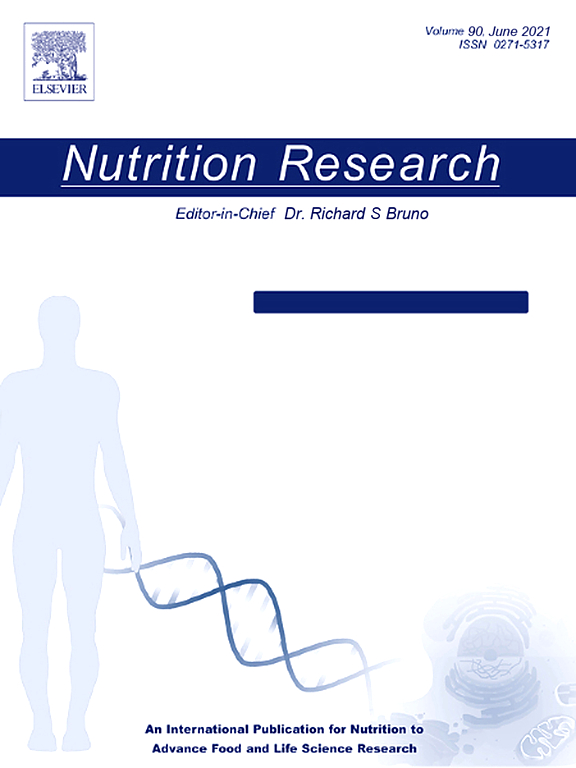Plasma advanced glycation products are associated with increased risk of depression in middle-aged and elderly Chinese adults
IF 3.1
3区 医学
Q2 NUTRITION & DIETETICS
引用次数: 0
Abstract
Depression is becoming a critical health challenge for the middle-aged and elderly populations. Existing evidence on the associations between body accumulations of advanced glycation end products (AGEs) and depression remain inconsistent. We hypothesized that plasma AGEs concentration might be positively correlated with the incidence of depression in middle-aged and elderly adults. In this cross-sectional study with 586 participants (201 males and 385 females, mean age: 62.18 years old) from Suzhou city, depression was assessed via the Center for Epidemiologic Studies Depression scale 10-item version (CES-D-10). Plasma AGEs of free Nε-carboxymethyl-L-lysine (CML), Nε-(1-carboxyethyl) lysine (CEL), and Nδ-(5-hydro-5-methyl-4-imidazolon-2-yl)-ornithine (MG-H1), as well as protein bound CEL and CML were measured with ultraperformance liquid chromatography and tandem mass spectrometry. Multivariate linear regression analysis and logistic regression analysis were utilized to determine the associations between specific plasma AGEs and CES-D-10 score and the incidence of depression, respectively. The incidence of depression was 8.02%. Plasma protein bound CEL and CML concentration were positively correlated with CES-D-10 score (CEL: β=0.12, P=0.018; CML: β=0.14; P=0.034) in the linear regression analysis. Compared to those below the median concentration of bound CEL and CML, participants with bound CEL and CML concentration above the median had increased risk of depression [ORs (95% CI): 2.33 (1.13-4.84), P=0.023, and ORs (95% CI): 2.27 (1.16-4.43), P=0.016, respectively] in the logistic regression analysis. Elevated plasma bound CEL and CML might be associated with increased risk of depression. Further studies are required to confirm the associations between specific AGEs and the risk of depression.

血浆晚期糖化产物与中国中老年人抑郁症风险增加相关
抑郁症正成为中老年人群面临的重大健康挑战。关于晚期糖基化终产物(AGEs)的体内积累与抑郁症之间关系的现有证据仍然不一致。我们假设血浆AGEs浓度可能与中老年人抑郁症的发病率呈正相关。本研究采用美国流行病学研究中心抑郁量表10题版(CES-D-10)对来自苏州市的586名参与者(201名男性,385名女性,平均年龄:62.18岁)进行抑郁评估。采用超高效液相色谱和串联质谱法测定血浆游离Nε-羧甲基-l -赖氨酸(CML)、Nε-(1-羧乙基)赖氨酸(CEL)和Nδ-(5-氢-5-甲基-4-咪唑啉-2-基)鸟氨酸(MG-H1)的AGEs以及蛋白结合的CEL和CML。采用多元线性回归分析和logistic回归分析分别确定特异性血浆AGEs和CES-D-10评分与抑郁发生率的关系。抑郁发生率为8.02%。血浆蛋白结合CEL和CML浓度与CES-D-10评分呈正相关(CEL: β=0.12, P=0.018;CML:β= 0.14;P=0.034)。在logistic回归分析中,与低于结合型CEL和CML中位数浓度的受试者相比,结合型CEL和CML中位数浓度高于中位数的受试者抑郁风险增加[or (95% CI): 2.33 (1.13-4.84), P=0.023, or (95% CI): 2.27 (1.16-4.43), P=0.016]。血浆结合的CEL和CML升高可能与抑郁症风险增加有关。需要进一步的研究来证实特定年龄与抑郁症风险之间的联系。
本文章由计算机程序翻译,如有差异,请以英文原文为准。
求助全文
约1分钟内获得全文
求助全文
来源期刊

Nutrition Research
医学-营养学
CiteScore
7.60
自引率
2.20%
发文量
107
审稿时长
58 days
期刊介绍:
Nutrition Research publishes original research articles, communications, and reviews on basic and applied nutrition. The mission of Nutrition Research is to serve as the journal for global communication of nutrition and life sciences research on diet and health. The field of nutrition sciences includes, but is not limited to, the study of nutrients during growth, reproduction, aging, health, and disease.
Articles covering basic and applied research on all aspects of nutrition sciences are encouraged, including: nutritional biochemistry and metabolism; metabolomics, nutrient gene interactions; nutrient requirements for health; nutrition and disease; digestion and absorption; nutritional anthropology; epidemiology; the influence of socioeconomic and cultural factors on nutrition of the individual and the community; the impact of nutrient intake on disease response and behavior; the consequences of nutritional deficiency on growth and development, endocrine and nervous systems, and immunity; nutrition and gut microbiota; food intolerance and allergy; nutrient drug interactions; nutrition and aging; nutrition and cancer; obesity; diabetes; and intervention programs.
 求助内容:
求助内容: 应助结果提醒方式:
应助结果提醒方式:


